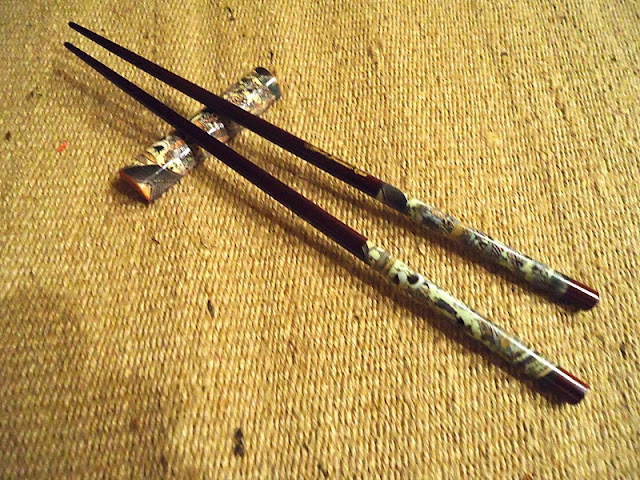We recently received a lovely gift, containing a beautiful set of chopsticks. Which prompted me to remind myself and others of the proper etiquette regarding the use of chopsticks...
Thank you Dr. P.L. for everything! :)
~~~
First... a very brief
History on Chopsticks:
Chopsticks originated in ancient China as early as the Shang Dynasty, 1122 BC.
The earliest evidence of chopsticks found were made of bronze, and excavated from the ruins of Yin near Anyang, Henan, dating roughly around 1200 BC. The earliest known text about chopsticks was written by Han Fei in the 3rd century.
**This section will cover, for the most part, "Chinese Chopsticks Etiquette", etiquette rules vary throughout different regions. When traveling to those regions, please check for proper etiquette rules regarding that country.
There are many types & uses regarding chopsticks; Chinese, Japanese, Korean, Vietnamese, Thailand, Burma and Northern provinces of Laos and others. Chopsticks are most commonly made of bamboos & woods, also plastic, bone and metal.
In the Chinese language, chopsticks are called "kuaizi". Which translates to "quick bamboo".
Chopsticks are traditionally used in the right hand, even by some left handed people. Although today, some people do use them in both hands, a few people still consider "left handed chopstick use" improper etiquette. To some, this practice prevents left handed people from accidentally elbowing a right handed person when seated closely together.
Chinese sticks may be longer, and may be square or round in the cross section where they contact food. The end of the chopstick is blunt.
In the Chinese language, chopsticks are called "kuaizi". Which translates to "quick bamboo".
Chopsticks are traditionally used in the right hand, even by some left handed people. Although today, some people do use them in both hands, a few people still consider "left handed chopstick use" improper etiquette. To some, this practice prevents left handed people from accidentally elbowing a right handed person when seated closely together.
Chinese sticks may be longer, and may be square or round in the cross section where they contact food. The end of the chopstick is blunt.
Etiquette:
Chopsticks are used in many parts of the world. Principles of etiquette are similar, but the finer points may differ between regions. Generally, chopstick etiquette is similar to the general western etiquette rules regarding eating utensils.
Universal etiquette:
~Chopsticks are not used to make noise, draw attention, or to make gestures. Never point with a chopstick.
~Playing with chopsticks is considered bad manners, just as it is with western untensils.
~Never use them to move bowls, plates or non-food items.
~Do not use them to play with one's food.
~Chopsticks are not used to impale, poke or spear food.
~Never leave chopsticks standing vertical in bowl of rice or food. Use your "holder" to place the chopsticks. If no holder, chopsticks may be placed together across the top of bowl or plate with "points" facing left.
FYI ~*Any pair of stick-like objects pointed upwards resemble incense sticks, that some asians use as offerings to honor deceased family members. Certain funeral rites designate offerings of food to the dead using standing chopsticks.
~~~
Chinese Etiquette:
~In Chinese culture , it is normal to hold the rice bowl and use the chopsticks to push the rice into the mouth. Rice is very rarely served on a plate.
~It is acceptable to transfer food to a closely related person if they are have trouble picking up the food with chopsticks. It is also a sign of respect to pass the food to the elderly first, before the dinner starts.
~It is poor etiquette to tap your chopsticks on the edge of your bowl. It is considered rude as beggar's are believed to to make this noise to attract attention.
~Holding chopsticks improperly reflects badly on a child's parent, as it is their responsibility to teach their children proper chopstick etiquette.
~Serving Chopsticks are used to take food from serving dishes. These are usually a different color than the ones you use while eating. Serving spoons may also be present.
FYI ~*If you need to use your personal chopsticks to serve yourself from the communal bowl, turn them around and use the opposite end to do so.
~Never use your chopsticks to dig for food. Take what is closest to you, whatever you touch is yours.
~Chopsticks must be the same length as each other. If they do not match, request another set from the waiter.
Below is a darling example of children's chopsticks. Some say these help to easily teach a child how to use chopsticks. The sticks may be removed and the toy on top then becomes the holder.
I don't know if they help teach or not...but they are very CUTE!
Learning to use Chopsticks with Grace and Style.....






2 comments :
Now I have an idea on what should I do if ever I am invited to a dinner by my Asian friends, I never really thought that there are some etiquette to follow in using chopsticks. I am guilty of using kids chopsticks years ago, well it sure help me a lot to learn how to use a personalized chopsticks properly.
Glad this post helped.....hope it works well for you....thanks so much for your comment...have a stylish day....:)NeeCee
Post a Comment